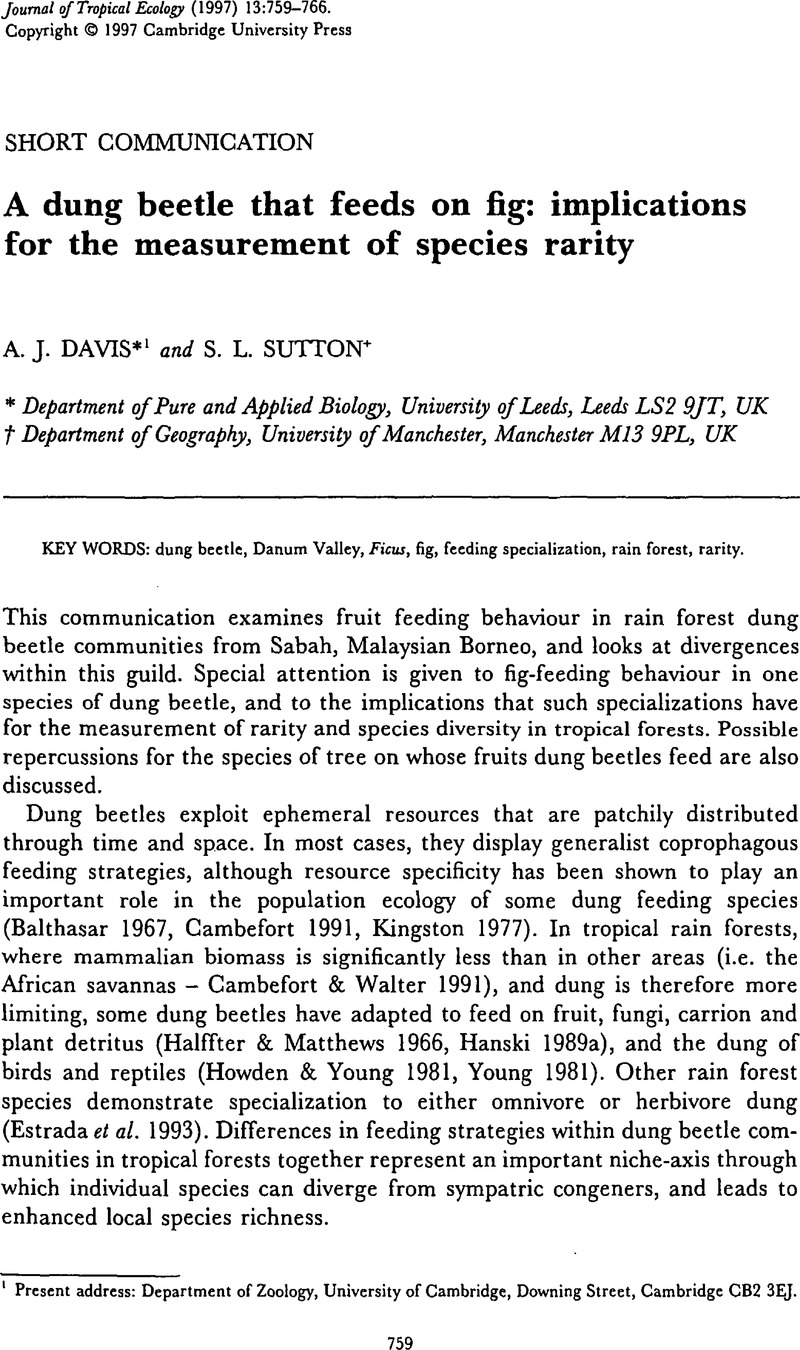Crossref Citations
This article has been cited by the following publications. This list is generated based on data provided by Crossref.
Davis, Andrew J.
2000.
Species Richness of Dung-Feeding Beetles (Coleoptera: Aphodiidae, Scarabaeidae, Hybosoridae) in Tropical Rainforest at Danum Valley, Sabah, Malaysia.
The Coleopterists Bulletin,
Vol. 54,
Issue. 2,
p.
221.
SHANAHAN, MIKE
SO, SAMSON
GOMPTON, STEPHEN G.
and
GORLETT, RICHARD
2001.
Fig‐eating by vertebrate frugivores: a global review.
Biological Reviews,
Vol. 76,
Issue. 4,
p.
529.
Chapman, Colin A.
Chapman, Lauren J.
Vulinec, Kevina
Zanne, Amy
and
Lawes, Michael J.
2003.
Fragmentation and Alteration of Seed Dispersal Processes: An Initial Evaluation of Dung Beetles, Seed Fate, and Seedling Diversity1.
BIOTROPICA,
Vol. 35,
Issue. 3,
p.
382.
Chapman, Colin A.
Chapman, Lauren J.
Vulinec, Kevina
Zanne, Amy
and
Lawes, Michael J.
2003.
Fragmentation and Alteration of Seed Dispersal Processes: An Initial Evaluation of Dung Beetles, Seed Fate, and Seedling Diversity1.
Biotropica,
Vol. 35,
Issue. 3,
p.
382.
Hamer, K. C.
Hill, J. K.
Benedick, S.
Mustaffa, N.
Sherratt, T. N.
Maryati, M.
and
K., Chey V.
2003.
Ecology of butterflies in natural and selectively logged forests of northern Borneo: the importance of habitat heterogeneity.
Journal of Applied Ecology,
Vol. 40,
Issue. 1,
p.
150.
Emlen, Douglas J.
Marangelo, Jennifer
Ball, Bernard
and
Cunningham, Clifford W.
2005.
DIVERSITY IN THE WEAPONS OF SEXUAL SELECTION: HORN EVOLUTION IN THE BEETLE GENUS ONTHOPHAGUS (COLEOPTERA: SCARABAEIDAE).
Evolution,
Vol. 59,
Issue. 5,
p.
1060.
Emlen, Douglas J.
Marangelo, Jennifer
Ball, Bernard
and
Cunningham, Clifford W.
2005.
DIVERSITY IN THE WEAPONS OF SEXUAL SELECTION: HORN EVOLUTION IN THE BEETLE GENUS ONTHOPHAGUS (COLEOPTERA: SCARABAEIDAE).
Evolution,
Vol. 59,
Issue. 5,
p.
1060.
Larsen, Trond H.
Lopera, Alejandro
and
Forsyth, Adrian
2006.
Extreme Trophic and Habitat Specialization by Peruvian Dung Beetles (Coleoptera: Scarabaeidae: Scarabaeinae).
The Coleopterists Bulletin,
Vol. 60,
Issue. 4,
p.
315.
Whipple, Sean D.
and
Hoback, W. Wyatt
2012.
A Comparison of Dung Beetle (Coleoptera: Scarabaeidae) Attraction to Native and Exotic Mammal Dung.
Environmental Entomology,
Vol. 41,
Issue. 2,
p.
238.
Whipple, Sean D.
Lindroth, Erica J.
Hoback, W. Wyatt
Albrecht, Marc C.
and
Foster, John E.
2012.
Genetic Variability ofDigitonthophagus gazella(F.) (Coleoptera: Scarabaeidae) from Vieques, Puerto Rico and South Africa.
The Coleopterists Bulletin,
Vol. 66,
Issue. 1,
p.
45.
JONES, ASHER G.
FORGIE, SHAUN A.
SCOTT, DAVID J.
and
BEGGS, JACQUELINE R.
2012.
Generalist dung attraction response in a New Zealand dung beetle that evolved with an absence of mammalian herbivores.
Ecological Entomology,
Vol. 37,
Issue. 2,
p.
124.
Kishimoto-Yamada, Keiko
Hyodo, Fujio
Matsuoka, Masayuki
Hashimoto, Yoshiaki
Kon, Masahiro
Ochi, Teruo
Yamane, Seiki
Ishii, Reiichiro
and
Itioka, Takao
2013.
Effects of remnant primary forests on ant and dung beetle species diversity in a secondary forest in Sarawak, Malaysia.
Journal of Insect Conservation,
Vol. 17,
Issue. 3,
p.
591.
Ratcliffe, Brett C.
2013.
The Dung- and Carrion-Feeding Scarabs (Coleoptera: Scarabaeoidea) of an Amazonian Blackwater Rainforest: Results of a Continuous, 56-Week, Baited-PitfallTrap Study.
The Coleopterists Bulletin,
Vol. 67,
Issue. 4,
p.
481.
Stavert, J. R.
Gaskett, A. C.
Scott, D. J.
and
Beggs, J. R.
2014.
Dung beetles in an avian-dominated island ecosystem: feeding and trophic ecology.
Oecologia,
Vol. 176,
Issue. 1,
p.
259.
Breeschoten, Thijmen
Doorenweerd, Camiel
Tarasov, Sergei
and
Vogler, Alfried P.
2016.
Phylogenetics and biogeography of the dung beetle genus Onthophagus inferred from mitochondrial genomes.
Molecular Phylogenetics and Evolution,
Vol. 105,
Issue. ,
p.
86.
Hewavithana, Dishane K.
Wijesinghe, Mayuri R.
Dangalle, Chandima D.
and
Dharmarathne, H. A. S. Gayan
2016.
Habitat and dung preferences of scarab beetles of the subfamily Scarabaeinae: a case study in a tropical monsoon forest in Sri Lanka.
International Journal of Tropical Insect Science,
Vol. 36,
Issue. 02,
p.
97.
Palmieri, Luciano
and
Pereira, Rodrigo Augusto Santinelo
2018.
The role of non-fig-wasp insects on fig tree biology, with a proposal of the F phase (Fallen figs).
Acta Oecologica,
Vol. 90,
Issue. ,
p.
132.
Ebert, Kathryn M
Monteith, Geoff B
Menéndez, Rosa
and
Merritt, David J
2019.
Bait preferences of Australian dung beetles (Coleoptera: Scarabaeidae) in tropical and subtropical Queensland forests.
Austral Entomology,
Vol. 58,
Issue. 4,
p.
772.
Parker, Erik S.
Dury, Guillaume J.
and
Moczek, Armin P.
2019.
Transgenerational developmental effects of species‐specific, maternally transmitted microbiota in Onthophagus dung beetles.
Ecological Entomology,
Vol. 44,
Issue. 2,
p.
274.
Perrin, William
Jay-Robert, Pierre
Buatois, Bruno
and
Tatin, Laurent
2019.
A Comparative Analysis of Dung Beetle Assemblages (Coleoptera: Scarabaeidae: Scarabaeinae, Aphodiinae) Attracted to Sheep and Little Bustard Excrement in Southern France.
The Coleopterists Bulletin,
Vol. 73,
Issue. 1,
p.
185.





